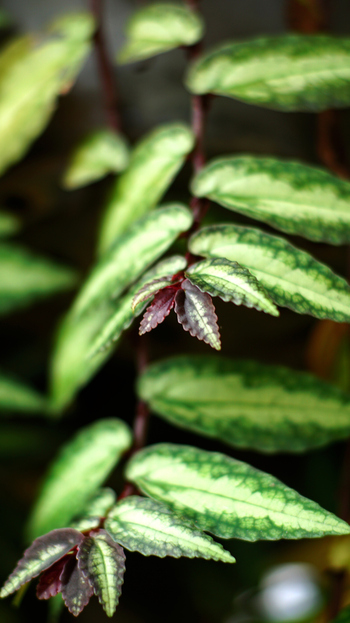
Pellionia, often called Watermelon Pellionia or Trailing Watermelon Begonia, is a lush, fast-growing indoor plant admired for its striking patterned foliage and cascading stems. Its olive-green leaves are painted with silver and deep green veins that resemble the rind of a watermelon, creating a dynamic texture that stands out in both modern and natural interior spaces. With its trailing habit, Pellionia is perfect for hanging planters, plant shelves, or terrariums, where it adds soft movement and lush greenery.
Pellionia thrives in bright, indirect light, which helps maintain its vibrant leaf patterns and encourages full, bushy growth. Place your Pellionia near an east- or north-facing window, or in a bright room where sunlight is filtered. Too much direct sun can scorch or bleach the leaves, while too little light may cause the plant to stretch and lose its distinctive markings.
If your home is on the dim side, a gentle grow light set for 8–10 hours a day will keep the plant healthy and compact.
This plant prefers consistently moist soil, similar to the conditions of its native tropical forest floors. Water your Pellionia when the top half-inch of soil feels lightly dry, and ensure the water flows freely through the drainage holes. Avoid letting the soil become waterlogged, as this can lead to root rot.
Pellionia is sensitive to drying out. Crispy edges, wilting stems, and faded colours are signs that it’s waiting too long between waterings. In winter, slightly reduce watering but never allow the soil to fully dry.
Pellionia loves high humidity — ideally around 60% or more. It thrives in steamy spaces like kitchens and bathrooms but also does well with a humidifier nearby. Its delicate leaves can crisp in dry air, so consider grouping your Pellionia with other humidity-loving plants or placing it on a pebble tray with water.
The plant grows best in temperatures between 65–80°F (18–27°C). Keep it away from cold drafts, heaters, or air conditioning vents, as sudden temperature changes can cause leaf drop.
Choose a light, airy potting mix that retains some moisture without becoming compact. A peat-based mix with added perlite or coco coir works well. Pellionia has delicate roots, so choose a pot only slightly larger than the rootball and make sure it has good drainage.
Repot every 1–2 years, ideally in spring, to refresh the soil and give the plant room to spread its trailing stems.
Feed your Pellionia every 4–6 weeks during spring and summer using a balanced liquid fertilizer diluted to half strength. Too much fertilizer can cause leaf burn or weakened growth, so keep feedings gentle and infrequent. Stop fertilizing in winter when the plant’s growth naturally slows.
Pellionia grows quickly and may become long or leggy over time. Regular pruning helps maintain a full, cascading shape. Trim back straggling stems using clean scissors, and pinch new growth to encourage branching. Removed cuttings can be used for propagation.
The plant’s trailing stems make it a beautiful choice for hanging planters, but it can also be trained to grow across soil or small supports for extra texture.
Propagation is easy and reliable through stem cuttings. Simply remove a healthy segment with at least two nodes, remove the lower leaves, and place the stem in water or moist soil. Roots typically form within one to two weeks. Once rooted, transfer the cutting to a small pot or plant it back into the parent pot for a fuller look.
Pellionia is considered non-toxic to pets, making it a safe option for homes with cats and dogs. As always, it’s still best to keep plants out of chewing range to protect both your pets and your plant’s beautiful foliage.